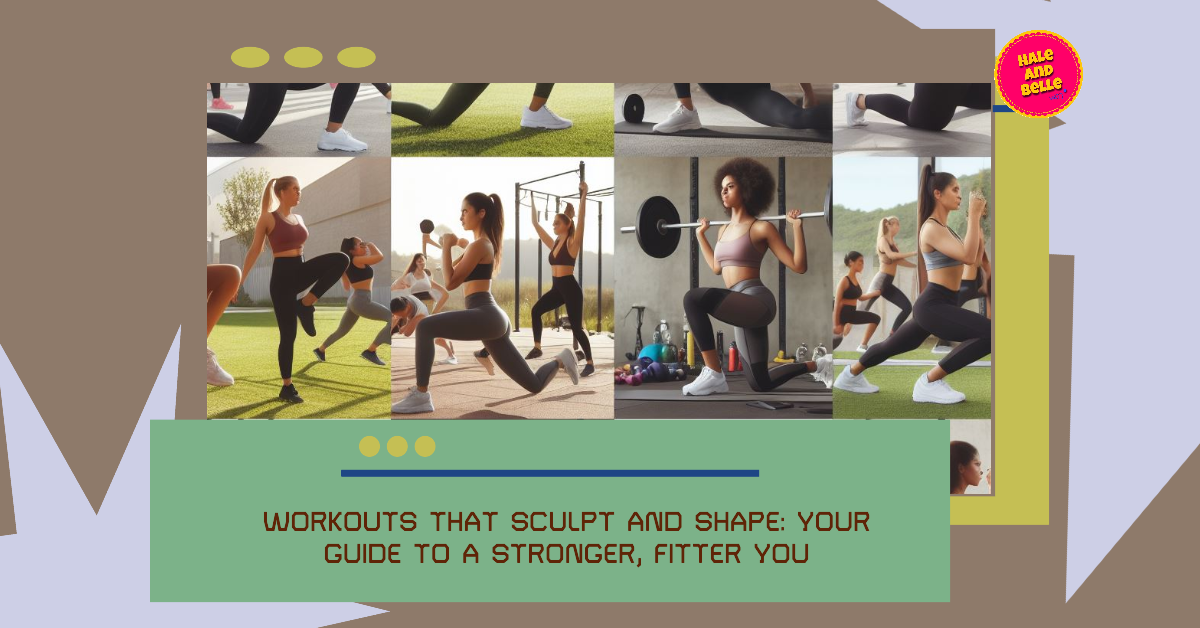With our jam-packed schedules, staying healthy can feel like a juggling act. But small changes and smart choices make a big difference! A well-rounded workout routine not only enhances physical strength but also contributes to mental well-being. Whether you are aiming to shed those extra pounds, tone muscles, or simply enhance your overall fitness level, the right workout regimen can help you achieve your goals. Let us explore effective workouts and the strategies that can shape and sculpt a stronger, fitter you.
In This Article
- 1 The ABCs of Workouts: Your Essential Guide to Getting Started
- 2 Balanced Fitness: A Sample Weekly Workout Plan for All Levels
- 3 Saturday: HIIT and Cardio
- 4 Consistency and Progression in Fitness
- 5 Fuel Your Fitness Journey: Essential Nutrition Tips
- 6 Takeaway:
- 7 Share with your friends:
- 8 Like this:
- 9 Related
The ABCs of Workouts: Your Essential Guide to Getting Started
Before diving into specific workouts, it is crucial to understand the fundamentals of exercise. Incorporating a balanced combination of cardiovascular exercises, strength training, and flexibility routines forms the cornerstone of a comprehensive workout plan.
Cardiovascular Workouts for Endurance:
Cardiovascular exercise is indispensable for individuals aiming to burn calories, enhance cardiovascular health, and elevate metabolic rate. By incorporating cardio workouts into your routine, you can effectively torch calories while improving endurance and stamina.
Running stands out as a quintessential cardio exercise, burning approximately 600-800 calories per hour, depending on factors such as speed and intensity. For beginners, starting with brisk walking or jogging intervals can gradually build up endurance. Intermediate individuals may progress to running at a steady pace, while advanced runners might challenge themselves with high-intensity interval runs or uphill sprints.
Swimming offers a full-body workout with minimal impact on joints, making it an excellent choice for those seeking low-impact cardio. Depending on stroke and intensity, swimming can burn up to 500-700 calories per hour. Beginners can start with freestyle or breaststroke, gradually increasing distance and speed. Intermediate swimmers may incorporate interval training or different strokes, while advanced swimmers can challenge themselves with longer distances or speed drills.
Cycling, whether outdoors or on a stationary bike, provides an effective cardio workout, burning approximately 400-600 calories per hour. Beginners can begin with leisurely rides or indoor cycling classes. Intermediate cyclists may progress to longer rides at moderate intensity, while advanced cyclists might engage in high-intensity interval training or hill climbs to maximize calorie burn and cardiovascular benefits.
Consistency and progression are key to reaping the benefits of cardio exercise. Start at a level that matches your current fitness level and gradually increase intensity, duration, or resistance as you improve. By incorporating a variety of cardio exercises into your routine, you can keep workouts exciting while achieving your fitness goals effectively (1).
Strength Training for Muscle Definition:
Strength training plays a crucial role in transforming your body by not only sculpting and toning muscles but also boosting metabolism, leading to more efficient calorie burning even at rest. It creates microscopic tears (micro-tears) in your muscle fibres. As your body repairs these tears, it expends energy, which in turn increases your basal metabolic rate (BMR). Over time, as you build more muscle mass, your BMR rises, meaning you burn more calories even when you are not actively exercising. This phenomenon makes strength training an invaluable tool for weight management and fat loss.
Beyond its metabolic benefits, strength training enhances muscle definition, improves overall body composition, and increases functional strength. Whether your goal is to build lean muscle, sculpt specific areas, or simply improve your physical capabilities, incorporating strength training into your routine is essential.
For beginners, bodyweight exercises offer an accessible and effective entry point into strength training. Simple yet powerful exercises like squats, lunges, and push-ups engage multiple muscle groups simultaneously, promoting functional strength and stability. To perform a squat, stand with feet shoulder-width apart, lower your body by bending your knees and pushing your hips back, then return to the starting position by pushing through your heels. Lunges involve stepping forward with one foot, bending both knees to lower your body, and then pushing back up to the starting position. Push-ups target the chest, shoulders, and triceps; begin in a plank position, lower your body until your chest nearly touches the ground, then push back up.
For those seeking an extra challenge, incorporating light weights or resistance bands can add intensity and variation to bodyweight exercises, further enhancing muscle strength and endurance (2).
High-Intensity Interval Training (HIIT) for Efficiency:
High-Intensity Interval Training (HIIT) is a workout strategy that involves alternating between short bursts of intense exercise and brief recovery periods. This high-intensity approach challenges the cardiovascular system, boosts metabolism, and maximizes calorie burn in a shorter amount of time.
One of the key benefits of HIIT is its efficiency in burning calories. The intense bursts of activity push the body to work at its maximum capacity, triggering the afterburn effect, also known as excess post-exercise oxygen consumption (EPOC). This phenomenon causes the body to continue burning calories at an elevated rate even after the workout is complete, leading to increased calorie expenditure throughout the day (3).
Beginner-Friendly HIIT Routine: A Step-by-Step Guide
Warm-Up: Start with a 5-minute dynamic warm-up to prepare the body for exercise. This can include exercises such as arm circles, leg swings, and light jogging in place.
Interval Set: Perform each exercise at maximum effort for 30 seconds, followed by a 30-second rest or active recovery period. Repeat this cycle for a total of 4-5 rounds.
- Jumping Jacks: Begin with jumping jacks, a full-body exercise that elevates heart rate and engages multiple muscle groups.
- Bodyweight Squats: Transition to bodyweight squats, focusing on proper form and depth to target the lower body muscles effectively.
- Mountain Climbers: Move into mountain climbers, a dynamic core exercise that also improves cardiovascular endurance.
- Rest: Take a 1-minute rest break after completing one round of the interval set.
- Cool Down: Conclude the workout with a 5-minute cooldown, consisting of static stretches to improve flexibility and prevent muscle soreness.
This beginner-friendly HIIT routine provides a balanced mix of cardio and strength exercises while allowing for adequate rest between intervals. As fitness levels improve, individuals can gradually increase the intensity, duration, or complexity of exercises to continue challenging themselves and achieving fitness goals.
Functional Training for Everyday Strength:
Functional training is a fitness approach centered around movements that mimic real-life activities, aiming to enhance overall strength, stability, and coordination. Unlike traditional strength training, which often isolates specific muscles, functional exercises engage multiple muscle groups simultaneously, reflecting the movements required for daily tasks like lifting groceries, pushing a stroller, or bending to tie shoelaces. By prioritizing functional movements, individuals can improve their functional capacity, reduce the risk of injury, and enhance their overall quality of life.
Key benefits of functional training include:
- Improved Functional Capacity: Functional exercises target movements essential for everyday activities, allowing individuals to perform daily tasks with greater ease and efficiency. By strengthening muscles involved in activities like bending, lifting, and twisting, functional training enhances functional capacity, promoting independence and mobility.
- Enhanced Stability and Coordination: Functional exercises challenge the body to maintain balance and stability, improving proprioception and coordination. By incorporating dynamic movements that require coordination between different muscle groups, functional training helps individuals develop greater body awareness and control.
- Reduced Risk of Injury: By strengthening muscles involved in common movements and improving joint stability, functional training can help prevent injuries during daily activities and sports. Building strength in a functional context ensures that muscles work together synergistically, reducing the risk of imbalances and compensations that can lead to injury (4).
Examples of functional exercises include squats, lunges, planks, and kettlebell swings. These movements engage multiple muscle groups and emphasize stability and coordination, making them valuable additions to any workout routine. Whether performed with bodyweight or additional resistance, functional exercises contribute to overall functional fitness, allowing individuals to move with greater ease, efficiency, and confidence in their daily lives.
Balanced Fitness: A Sample Weekly Workout Plan for All Levels
Creating a well-rounded weekly workout plan involves balancing cardiovascular exercises, strength training, and rest days to optimize results while allowing for adequate recovery. Here’s a sample weekly workout plan that caters to different fitness levels:
Monday: Cardio and Strength Training
- Morning: 30-minute brisk walk or jog for beginners, 45-minute run for intermediates, or 60-minute HIIT session for advanced individuals.
- Afternoon: Strength training focusing on lower body for beginners (e.g., bodyweight squats, lunges, calf raises), full-body workout for intermediates (e.g., dumbbell squats, deadlifts, lunges, push-ups, rows), and advanced individuals can opt for heavier weights or advanced bodyweight exercises.
Tuesday: Active Recovery or Flexibility
- Active recovery day for all levels: Gentle yoga, stretching, or low-impact activities like swimming or cycling to promote recovery and flexibility.
Wednesday: Cardio and Core
- Morning: 30-minute moderate-intensity cycling or swimming for beginners, 45-minute cycling or swimming for intermediates, or 60-minute advanced spin class or swim session.
- Afternoon: Core-focused workout including exercises like planks, Russian twists, bicycle crunches, and leg raises. Beginners can start with shorter sets and fewer repetitions, while intermediates and advanced individuals can increase intensity and complexity.
Thursday: Strength Training
- Morning or Afternoon: Strength training focusing on upper body for beginners (e.g., push-ups, dumbbell rows, overhead press), full-body workout for intermediates, and advanced individuals can incorporate advanced exercises or heavier weights.
Friday: Rest or Active Recovery
- Rest day for all levels: Allow muscles to recover and prepare for the upcoming week. Light stretching or a leisurely walk can aid in active recovery.
Saturday: HIIT and Cardio
- Morning: High-intensity interval training (HIIT) session incorporating bodyweight exercises like jumping jacks, burpees, mountain climbers, and sprint intervals.
- Afternoon: Follow with a cardio workout such as running, cycling, or swimming for 30-45 minutes.
Sunday: Rest
- Complete rest day to allow for full recovery and rejuvenation. Take time for self-care activities like stretching, foam rolling, or leisurely walks.
By alternating between cardio, strength training, and rest days, this sample weekly workout plan provides a balanced approach to fitness while accommodating different fitness levels and goals. Adjustments can be made based on individual preferences, fitness levels, and schedules to ensure consistency and adherence to the plan.
Achieving a stronger, fitter version of yourself requires dedication, consistency, and a well-planned workout regimen. By incorporating a balanced mix of cardiovascular exercises, strength training, HIIT workouts, functional training, and flexibility routines, you can shape and sculpt your body while improving overall health and well-being. Remember to listen to your body, stay hydrated, and adjust your workouts as needed to ensure continued progress towards your fitness goals. Embrace the journey towards a stronger, fitter you, and enjoy the transformative benefits of a healthy, active lifestyle.
Consistency and Progression in Fitness
Consistency and progression are fundamental principles that underpin successful fitness journeys, yielding long-term results and sustainable improvements in overall health and well-being.
Consistent exercise forms the cornerstone of any effective fitness regimen. By committing to regular workouts, individuals establish a routine that fosters discipline and accountability, laying the groundwork for lasting habits. Consistency not only enhances physical fitness but also cultivates mental resilience, boosting mood, reducing stress, and improving overall quality of life. Whether it’s a daily walk, weekly gym sessions, or monthly fitness classes, maintaining a consistent exercise schedule is key to achieving and maintaining fitness goals over time.
In addition to consistency, the concept of progressive overload is essential for continual improvement and adaptation. Progressive overload involves gradually increasing the intensity, duration, or volume of exercise to continually challenge the body and stimulate further adaptations. By progressively challenging muscles, cardiovascular system, and other physiological systems, individuals can avoid plateaus and continue making gains in strength, endurance, and performance.
For example, increasing the weight lifted during strength training, adding an extra mile to a run, or reducing rest periods between sets are all forms of progressive overload. This gradual increase in demand forces the body to adapt by building stronger muscles, improving cardiovascular efficiency, and enhancing overall fitness levels.
Consistency and progression work hand in hand, with consistent effort providing the foundation for progressive improvements. By adhering to a regular exercise routine and gradually increasing the challenge over time, individuals can unlock their full potential and achieve lasting results in their fitness journey.
Fuel Your Fitness Journey: Essential Nutrition Tips
Conquering your fitness goals requires a two-pronged attack: exercise and smart nutrition. What you eat significantly impacts your energy levels, recovery, and overall performance. Power up your workouts and optimize recovery with these essential nutrition strategies:
Embrace Whole Foods:
Ditch processed junk and prioritize whole, unprocessed foods like fruits, vegetables, whole grains, and lean protein. These provide essential vitamins, minerals, and fibre for optimal health.
Find Your Macronutrient Balance:
Macronutrients (carbs, protein, fat) play crucial roles. Carbs provide energy, protein supports muscle building and repair, and healthy fats keep you satiated. Experiment to find a balance that works for your body and exercise regime.
Prioritize Protein:
Stronger muscles start with protein! Make it a star player in your diet. Aim for protein sources like lean meats, fish, eggs, legumes, or tofu throughout the day, especially after workouts.
Do not Fear Healthy Fats:
Healthy fats from sources like avocados, nuts, seeds, and olive oil are crucial for hormone regulation, satiety, and nutrient absorption. Include them in moderation as part of your balanced meals.
Stay Hydrated:
Water is vital for transporting nutrients, regulating body temperature, and lubricating joints. Stay hydrated! Sip water all day, especially before, during, and after workouts.
Plan Your Meals:
Planning meals and snacks helps you avoid unhealthy choices when hunger strikes. Prepping healthy options in advance keeps you on track, especially during busy schedules.
Listen to Your Body:
Respect your body’s hunger cues. Don’t skip meals, but stop when comfortably full. Eating intuitively helps you fuel your body effectively.
Make It Sustainable:
Do not deprive yourself! Allow occasional treats in moderation. Focus on building healthy habits you can maintain for long-term fitness success.
Remember, nutrition is a journey, not a destination. By incorporating these tips and fine-tuning them to your needs, you will be well on your way to achieving your fitness goals while feeling your best!
Takeaway:
Achieving a smaller dress size is not just about the numbers on the scale but about embracing a holistic approach to health and wellness. By incorporating regular exercise, balanced nutrition, and healthy habits into your lifestyle, you can achieve your fitness goals and feel confident in your own skin.
Remember, consistency is key. Stay committed to your workout routine and make smart choices when it comes to food. Focus on nourishing your body with nutrient-rich foods like fruits, vegetables, whole grains, and lean proteins. Avoid fad diets and quick fixes, and instead, opt for sustainable lifestyle changes that support long-term success.
Fuel your workouts and recovery with enough rest, hydration, and stress management. Celebrate your progress along the way and do not be too hard on yourself if you hit a bump in the road. Every step forward takes you closer to your summit – celebrate the climb!
Ultimately, the journey to a smaller dress size is about more than just physical appearance—it is about feeling great from the inside out. Embrace the process, enjoy the journey, and celebrate the small victories along the way. Challenges are inevitable, but your unwavering determination is your greatest weapon. Keep pushing forward! Each step forward builds momentum. Stay focused and crush it! You have got this!











